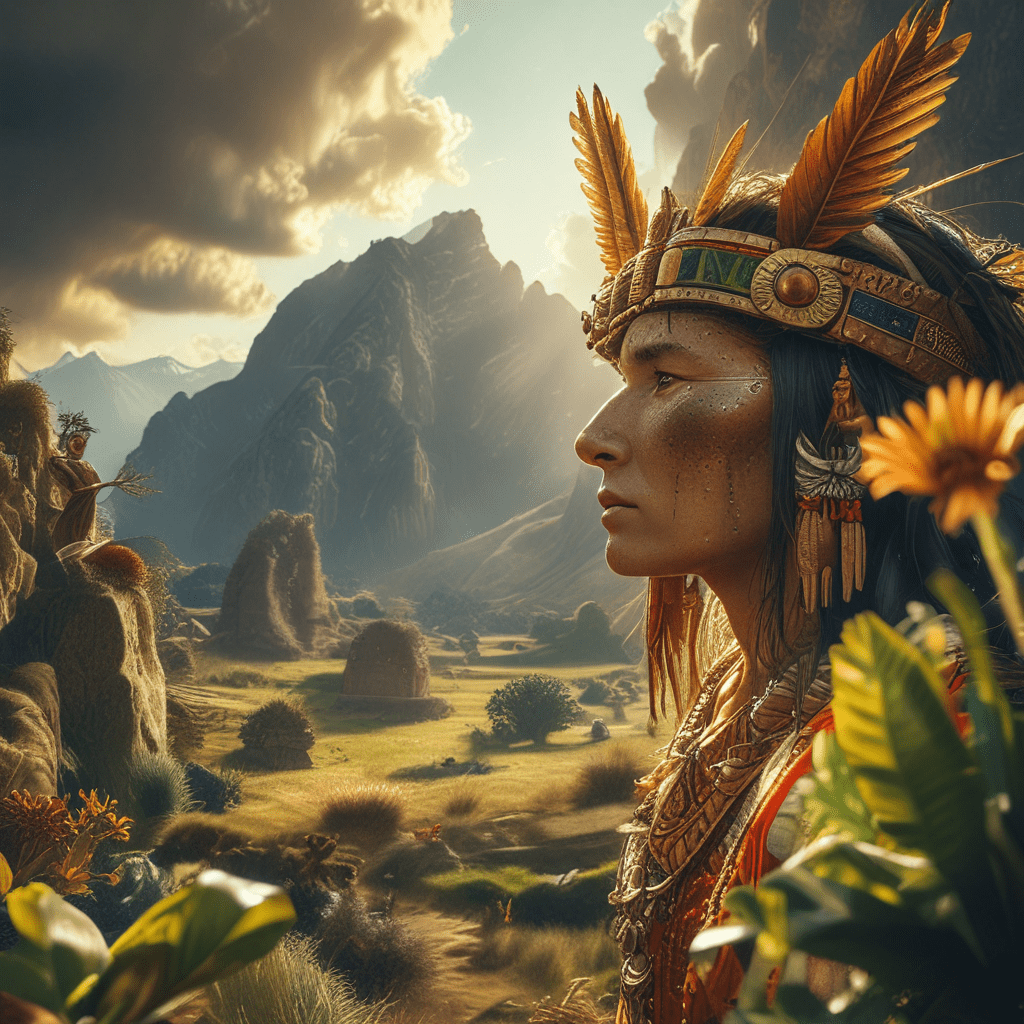Incan Mythology and Agriculture: The Sacred Connection to the Land
The Inca Empire, known for its impressive architectural feats and intricate social structure, was built upon a profound reverence for the natural world. Their mythology, deeply intertwined with their agricultural practices, reflected a profound understanding of the environment and its vital role in sustaining life. Unlike many other civilizations, the Inca did not simply view the land as a resource to be exploited. Instead, they saw it as a living entity, a sacred mother who provided for their needs and demanded respect in return. This sacred connection to the land formed the cornerstone of their culture and profoundly influenced their agricultural practices.
The Pachamama: Mother Earth as a Living Deity
At the heart of Incan mythology lies the concept of the Pachamama, the Earth Mother. The Pachamama was not simply a geographical entity but a living deity, a benevolent force that nurtured and sustained all life. She was revered as the provider of food, water, and all that grew from the earth. Her fertility was closely linked to the prosperity of the Inca people, and her wrath was feared when harvests failed or natural disasters struck. To appease the Pachamama, the Inca offered sacrifices, prayed for bountiful harvests, and meticulously maintained their fields.
The Sun God Inti: Life-Giving Force and Patron of Agriculture
In addition to the Pachamama, the Inca also worshipped the Sun God Inti, who played a vital role in their agricultural practices. Inti was seen as the life-giving force, the source of warmth and light that allowed crops to grow and flourish. He was also the patron of agriculture, and his presence was celebrated during the solstices and equinoxes, marking crucial periods for planting and harvesting. The Inca believed that Inti’s favor was essential for a successful harvest, and they offered him sacrifices of gold and llamas to ensure his continued blessing.
Viracocha: The Creator God and the Foundation of Civilization
Viracocha, the creator god, occupies a prominent role in Incan mythology. He is credited with bringing order to the universe, creating the world, and shaping the Inca people. It is believed that Viracocha, in his travels across the land, taught the Inca the art of agriculture, showing them how to cultivate the earth and grow crops. This legend reinforces the sacred nature of agriculture and Viracocha’s role in establishing the Inca’s way of life.
Incan Myths of Creation and the Origins of Agriculture
Many Incan myths and legends speak of the origins of agriculture and its significance to their people. One prominent story recounts how the first people were created from a rock by Viracocha and emerged from a cave, bringing with them the knowledge of cultivating the land. Another legend tells of the origin of maize, a staple food of the Inca, springing from the blood of a sacrificed hero. These narratives imbued agriculture with a sacred dimension and emphasized the deep connection between humans and the land.
The Sacred Landscape: Mountains, Rivers, and Fertility
The Incan worldview saw the natural landscape as a sacred tapestry, each element imbued with spiritual significance. Mountains, revered as the homes of deities, were believed to hold the life-giving forces of the earth. Rivers, symbolizing the flow of life and fertility, were seen as conduits of Pachamama’s power. The Inca developed a system of terraces and canals that harnessed the natural resources of the landscape, ensuring the fertility of their fields and the abundance of their harvests. Their reverence for the land extended to every aspect of their lives, and their agricultural practices were a testament to their deep spiritual connection to nature.
Rituals and Offerings: Honoring the Earth and Ensuring Bountiful Harvests
The Inca understood that the Pachamama's favor was not a given. They believed that to ensure bountiful harvests, they needed to honor the Earth Mother through rituals and offerings. These ceremonies were carefully planned and executed, reflecting the deep respect and reverence they held for the land.
One common practice was the "Capac Raymi", a grand festival held in June to honor the sun god Inti and celebrate the start of the agricultural season. During this festival, the Inca emperor would lead processions, offer sacrifices of llamas and gold to Inti, and pray for the sun's blessings on the crops.
Another important ritual was the "Mamacocha", a ceremony dedicated to the water spirits who inhabited the rivers and lakes. Offerings of coca leaves, corn, and other foods were made to these spirits, seeking their favor in ensuring the water supply necessary for irrigation and plant growth.
The Inca also practiced "Apu" rituals to honor the mountain deities, believed to be the protectors of the land and its inhabitants. These rituals were often performed at the summits of mountains, with offerings of coca leaves, llama wool, and other sacred objects.
The Significance of Maize: A Sacred Crop and Symbol of Life
Among the many crops cultivated by the Inca, maize, or corn, held a special place of reverence. It was not merely a staple food but a sacred crop, deeply intertwined with their mythology and beliefs.
In Incan mythology, maize is believed to have originated from the blood of a sacrificed hero. This legend highlights the importance of maize as a symbol of life, sacrifice, and the connection between humans and the divine.
Maize was also associated with the sun god Inti, who was believed to have bestowed its precious seeds upon the Inca people. The Inca believed that the sun's warmth and light were essential for the growth of maize, and they offered it to Inti as a symbol of gratitude and veneration.
Maize played a central role in Incan rituals and festivals. It was used as an offering to the Pachamama, the gods, and the ancestors. Maize was also incorporated into various religious ceremonies, reflecting its significance as a sacred crop that sustained life and represented the abundance of the earth.
Archaeological Evidence of Mythological Influences on Agriculture
Archaeological evidence provides a tangible connection between Incan mythology and their agricultural practices. The discovery of temples, shrines, and ceremonial sites dedicated to deities like Pachamama and Inti in close proximity to agricultural fields highlights the sacred nature of the land and its connection to the divine.
The discovery of offerings of food, coca leaves, and other sacred objects at these sites further reinforces the concept of rituals and offerings designed to ensure the fertility of the land and the abundance of the harvest.
The intricate system of terraces and canals, a marvel of Incan engineering, is also believed to have been inspired by their reverence for the natural landscape. These irrigation systems, designed to capture and manage water resources, were seen as a way to harness the life-giving forces of the earth and ensure the prosperity of their agriculture.
Theories on the Influence of Mythology on Incan Agricultural Practices
Scholars have proposed various theories about the influence of Incan mythology on their agricultural practices. One theory suggests that mythology provided a framework for understanding the natural world and guided their agricultural practices.
The belief in the Pachamama, the Earth Mother, and the importance of honoring her through rituals and offerings likely encouraged sustainable agricultural practices aimed at preserving the land's fertility. This focus on reverence for the land likely played a role in their successful agricultural achievements.
Another theory suggests that mythology provided social cohesion and a sense of shared purpose among the Inca people. The belief in shared ancestry and divine origins strengthened communal bonds and encouraged collective efforts in cultivating the land.
These theories highlight the profound connection between Incan mythology and their agricultural practices, demonstrating the power of belief systems in shaping cultural behaviors and shaping a society's relationship with the natural world.
The Enduring Influence of Incan Mythology in Andean Communities
The legacy of Incan mythology continues to influence Andean communities today. The reverence for the Pachamama, the sun god Inti, and the sacredness of the land remain deeply ingrained in their cultural practices and beliefs.
Many Andean communities continue to perform rituals and offerings to the Earth, the mountains, and the deities of their ancestors. These practices are seen as essential for ensuring the fertility of the land and the well-being of their communities.
The impact of Incan mythology on Andean agriculture is evident in their sustainable farming practices. The traditional methods of terraced farming, canal irrigation, and crop rotation developed by the Inca are still practiced today, ensuring the long-term productivity of the land.
The enduring influence of Incan mythology in Andean communities is a testament to the power of belief systems in shaping cultural identity and providing enduring values that guide community lifeways.
FAQ
What was the role of the Pachamama in Incan agriculture?
The Pachamama, the Earth Mother, was considered a benevolent deity responsible for the fertility of the land and the abundance of harvests. The Inca believed that honoring the Pachamama through rituals and offerings was essential for ensuring a prosperous agricultural season.
How did the belief in Inti influence Incan agriculture?
The sun god Inti was seen as the life-giving force, the source of the warmth and light that allowed crops to grow and flourish. The Inca celebrated Inti during solstices and equinoxes and offered sacrifices to him to ensure a successful harvest.
What evidence suggests a link between Incan mythology and agriculture?
Archaeological evidence of temples, shrines, and offerings dedicated to deities like Pachamama and Inti in close proximity to agricultural fields highlights the sacred nature of the land and its connection to the divine. The intricate system of terraces and canals developed by the Inca further demonstrates the influence of their reverence for the natural landscape on their agricultural practices.
How does Incan mythology continue to influence Andean communities today?
The reverence for the Pachamama, Inti, and the sacredness of the land remains deeply ingrained in Andean communities. They continue to perform rituals and offerings to the Earth and their ancestors, ensuring the fertility of the land. Traditional farming practices like terraced farming and canal irrigation developed by the Inca are still used, showcasing the enduring influence of Incan mythology on their agricultural practices and cultural identity.




